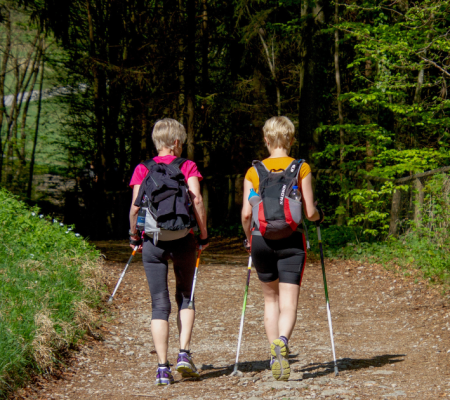Spring Hiking Safety: Tips To Avoid Common Hiking Hazards
As the snow has all melted away, it’s finally time to go out and enjoy nature. Hiking is a fantastic way to experience the outdoors and stay active, but it can also be challenging and potentially dangerous. When in nature, various terrains and environmental factors can easily cause injury to your bones, muscles, and joints if a few hiking safety precautions are exercised.
At Orthopaedic Hospital of Wisconsin, we want you to be prepared before your next hike to avoid orthopedic injury. We recommend the following hiking safety tips to prevent injury and enjoy a safe and healthy hiking experience.
-
Prepare Your Body
Before hitting the trail, prepare your body by doing warm-up exercises that target your legs, back, and core muscles. These exercises will help improve your balance, strength, and flexibility. This is essential for preventing injuries on the trail. While stretching alone cannot prevent injuries, you must be able to prepare your body for the physical activity ahead. It is also important to ensure your body is well hydrated and you’ve eaten enough before embarking on your hike.
Examples of Hiking Safety Warm-Up Stretches:
- Quad stretch: Stand upright and bring one foot towards your buttocks, holding onto it with the hand on the same side. Hold for 20-30 seconds. Then, switch sides.
- Hamstring stretch: Sit on the ground with one leg straight out and the other bent. Reach forward towards the outstretched foot, keeping the back straight. Hold for 20-30 seconds. Then, switch sides.
- Calf stretch: Stand with one foot in front of the other, keeping the back leg straight and the front leg bent. Press the back heel into the ground and lean forward towards the front leg. Hold for 20-30 seconds. Then, switch sides.
- Hip flexor stretch: Kneel on one knee and bring the other foot forward. Press the hips forward, keeping the back straight. Hold for 20-30 seconds. Then, switch sides.
- Shoulder stretch: Stand with arms at the side and raise one arm up and across the body, using the other arm to pull it towards the chest. Hold for 20-30 seconds. Then, switch sides.
-
Wear Appropriate Footwear
 Just like your everyday shoes, your hiking footwear should provide you with the proper support. Wear shoes or boots with good traction, ankle support, and a comfortable fit to prevent blisters, ankle sprains, and other foot-related injuries. Your shoe fit is also very important. If you are wearing new shoes, make sure to break them in before hitting the trail.
Just like your everyday shoes, your hiking footwear should provide you with the proper support. Wear shoes or boots with good traction, ankle support, and a comfortable fit to prevent blisters, ankle sprains, and other foot-related injuries. Your shoe fit is also very important. If you are wearing new shoes, make sure to break them in before hitting the trail.
-
Carry Appropriate Gear
While you don’t need tons of gear, coming to the hike prepared is essential to avoiding injury. Carry a well-stocked first aid kit, plenty of water, snacks, and appropriate clothing for the weather conditions. A walking stick or trekking pole can provide additional support and stability on challenging terrain.
-
Know Your Limits
Hiking can be challenging, especially on steep or rugged terrain. Be honest with yourself about your physical abilities, and know your limits. Plan your hike accordingly, and don’t push yourself too hard. Before selecting a hike, research the level of difficulty you will be experiencing. Reading Google Reviews or downloading apps such as All Trails can fill you in on the terrain you can expect on the hike, including elevation changes and trail conditions that may be hazardous.
-
Be Aware of Your Surroundings
Stay alert and aware of your surroundings. The last thing you want to experience on a relaxing hike is a fall. Watch out for loose rocks, slippery surfaces, and other potential hazards that can cause orthopedic injuries. Pay attention to trail markers, and don’t wander off the designated trail.
-
Take Breaks
Remember that hiking, while being physical, should be enjoyable. Take regular breaks to rest, hydrate, and refuel. This will help prevent fatigue, which can increase your risk of orthopedic injuries. Ensuring your body has the fuel it needs to complete the hike will prevent you from losing focus and falling or causing an overuse injury.
-
Listen to Your Body
If you experience pain, discomfort, or any other symptoms, stop and rest. Don’t try to push through the pain, as this can exacerbate your condition and increase your risk of injury. There is nothing wrong with not completing a hike. Start with shorter hikes and increase the length and difficulty of hikes over time. Your body will thank you!
Hiking is an excellent way to stay active and enjoy nature. However, it is essential to prioritize hiking safety and take precautions to prevent orthopedic injuries. If you are injured from an accident on the trail or have been experiencing a chronic condition preventing you from staying active, our team of orthopedic experts is here to help.
Make an appointment with the Orthopaedic Hospital of Wisconsin today by going online or calling (414) 961-6800.


